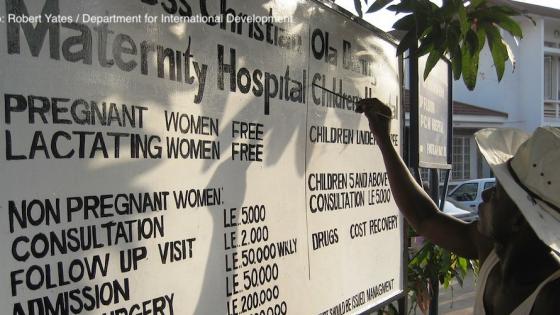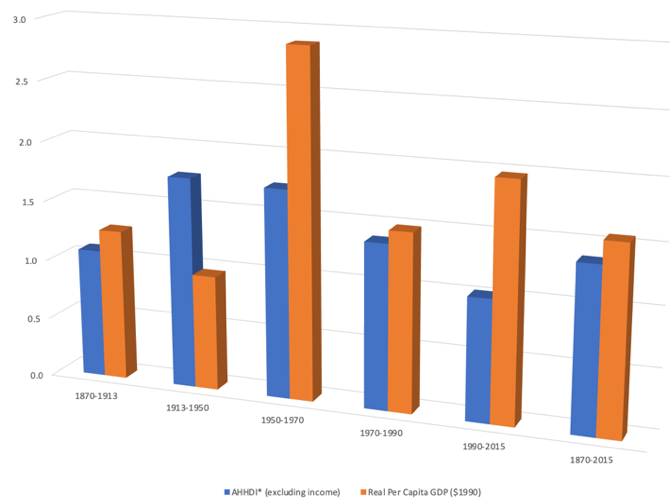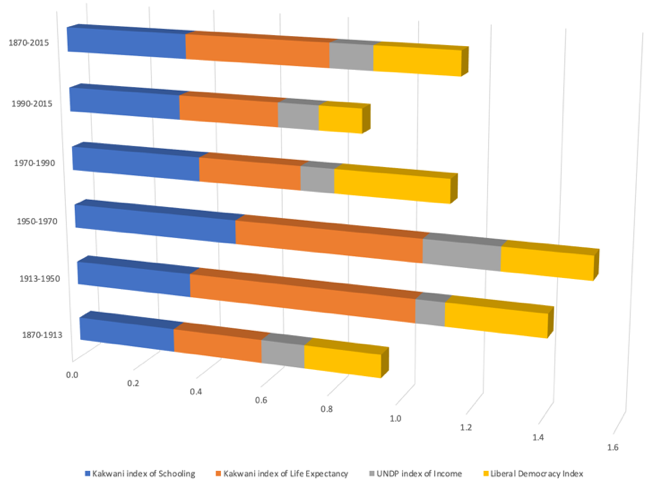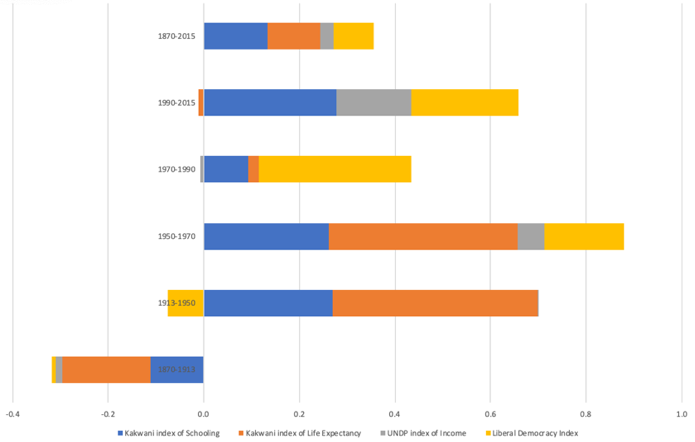Wellbeing is widely seen as a multi-dimensional phenomenon affected not only by material goods, but also health, education, agency and freedom, environment, and security (Fleurbaey 2009, Stiglitz et al. 2009). Among the multidimensional approaches to wellbeing, human development has been defined as “a process of enlarging people’s choices” (UNDP 1990: 10, 1993: 105).
In a new paper, I approach long-term wellbeing with an augmented historical human development index (AHHDI) that combines new measures of achievements in health, education, material living standards, and political freedom (Prados de la Escosura 2019). The AHHDI shows that world human development has steadily improved over time, raising its level 5.3-fold since 1870. Still, in 2015, the world average level remained below 0.5 on a scale of 0 to 1.
Human development (excluding the income dimension) exhibits slightly slower long-run growth than GDP per person (1.4% and 1.6%, respectively) throughout 1870-2015. A closer look reveals, however, that the pace at which human development progressed did not match that of real per capita GDP, with substantial discrepancies over the period 1913-1970 and since 2000 (Figure 1).
Figure 1 Augmented human development* and real per capita GDP growth (%)
Note: * excluding the income dimension
During the phase of globalisation backlash (1914-1950), real per capita GDP growth slowed down across the board as commodity and factor markets disintegrated, while human development thrived, particularly in less-developed regions. Conversely, in the post-1950 era, human development has advanced significantly less than real GDP per head.
These discrepancies derived from the fact that non-income dimensions have driven world human development gains over time (Figure 2). Life expectancy was the main contributor to its progress over 150 years, although the main contribution took place during 1914-1950 and in the 1960s, during which it provided half the human development gains. Education led the late-19th-century advance and was a steady contributor to human development over time (but for the 1940s) and political freedom made a substantial contribution in the 1900s, 1950s, and during 1980-2000.
Figure 2 Drivers of augmented human development in the world, 1870-2015 (yearly rate, %)
Advances in human development were unevenly distributed across world regions. An absolute gap between the most advanced regions – namely, Western Europe, the European offshoots, and Japan (hereafter referred to as ‘OECD’) – and the rest of the world (‘Rest’) broadened throughout 1870-2010.
In relative terms, however, the gap decreased since the beginning of the 20th century, especially in its central decades and again from 1990 onwards, so that by 2015, human development in the ‘Rest’ represented over half that of the OECD, doubling its share from a century earlier. The evolution of the ‘Rest’ vis-à-vis the OECD in terms of human development is at odds with that in per-capita-income terms, which presents a sustained deterioration: from nearly one-third of the OECD level in 1870 to less than 15% in 2000.
In the ‘Rest’, catching up to the OECD in terms of human development has taken place since 1900 and, especially, in the 1930s, the Golden Age (1950-70), and the last two decades of the 20th century. Education made the single most important contribution over the long run (Figure 3).
Figure 3 Augmented human development catching-up in the rest 1870–2015 (yearly rate, %)
Longevity emerges as the main dimension behind the early 20th century catching up of the ‘Rest’ in human development. It was the period that a large proportion of the ‘Rest’ was under colonial rule. In the 1960s, it was the time of active public policies across the board, and when China recovered from the Great Leap Forward debacle. Lastly, political freedom was the leading force behind the ‘Rest’ catching up prior to WWI, in the 1930s and 1950s, and during 1980-2000.
Why was the contribution of longevity to enhancing human development largely concentrated in the period 1920-1970? Health improvements can be depicted in terms of a health function (Preston 1975, Easterlin 1999). Movements along the function represent gains attributable to economic growth that improve nutrition – which strengthen the immune system and reduce morbidity (Fogel 2004) – and increase the public provision of health (Cutler and Miller 2005).
Outward shifts in the health function represent improvements in medical knowledge (Riley 2005, Cutler et al. 2006). This advancement in medical knowledge originated with the discovery of the germ theory of disease (Preston 1975) that led to the epidemiological or health transition. Persistent gains in lower mortality and higher survival were achieved since infectious disease gave way to chronic disease as the main cause of death (Omran 1971). The germ theory of disease led to the introduction of new vaccines (since the 1890s) and drugs to cure infectious diseases (sulphonamides since the late 1930s and antibiotics since the 1950s), along with chemicals such as DDT, which was instrumental in battling malaria (Easterlin 1999, Jayachandran et al. 2010, Lindgren 2016).
However, the germ theory of disease had another far-from-negligible effect: the diffusion of preventive methods of disease transmission and knowledge dissemination. These, through schooling and low-cost improvements in public health, had a profound impact in less-developed regions where low incomes precluded the purchase of the new drugs. As a result, mortality declined throughout the life course, with special impact on infant mortality and maternal death (Riley 2001).
The epidemiological transition spread beyond the OECD since the 1920s. This finding is at odds with the view that health improvements outside the West took off only since the 1940s because the absence of drugs and the lack of concern of colonial rulers prevented it up until then (Acemoglu and Johnson 2007). By 1970, the epidemiological transition was largely exhausted, helping to explain life expectancy’s declining contribution to human development thereafter.
Since 1990, a second health transition – translating into better treatment of respiratory and cardiovascular disease and vision problems – has led to mortality falling among the elderly, helped by better health and nutrition in their childhood (Eggleston and Fuchs 2012, Deaton 2013). The diffusion of new medical technologies has resulted in longer and healthier life years (Mathers et al. 2001, Hay et al. 2017).
This second health transition has been so far restricted to the OECD. The HIV/AIDS pandemic in sub-Saharan Africa and the collapse of socialism, plus the lack of public policies, help to explain life expectancy’s negative contribution to catching up in the Rest since 1990.
References
Acemoglu, D, and S Johnson (2007), “Disease and development: The effects of life expectancy on economic growth”, Journal of Political Economy 115: 925–985.
Cutler, D, and G Miller (2005), “The role of public health improvements in health advance: The twentieth century United States”, Demography 42(1): 1¬22.
Cutler, D, A Deaton and A Lleras-Muney (2006), “The determinants of mortality”, Journal of Economic Perspectives 20 (1): 97¬–120.
Deaton, A (2013), The Great Escape. Health, wealth and the origins of inequality, Princeton: Princeton University Press.
Easterlin, R A (1999), “How beneficient is the market? A look at the modern history of mortality”, European Review of Economic History 3: 257-294.
Eggleston, K N, and V Fuchs (2012), “The new demographic transition: Most gains in life expectancy now realized late in life”, Journal of Economic Perspectives 26(1): 137-156.
Fleurbaey, M (2009), “Beyond GDP: The quest for a measure of social welfare”, Journal of Economic Literature 47: 1029–1075.
Fogel, R W (2004), The escape from hunger and premature death, 1700–2010: Europe, America, and the Third World, New York: Cambridge University Press.
Hay, SI, et al. (2017), “Global, regional, and national disability-adjusted Life-years (DALYs) for 333 diseases and injuries and healthy life expectancy (HALE) for 195 countries and territories, 1990–2016: A systematic analysis for the global burden of disease study 2016”, Lancet 390: 1260-1344.
Jayachandran, S, A Lleras-Muney and K V Smith (2010), “Modern medicine and the twentieth century decline in mortality: Evidence on the impact of sulfa drugs”, American Economic Journal: Applied Economics 2(1): 118–146.
Lindgren, B (2016), “The rise in life expectancy, health trends among the elderly, and the demand for care. A selected literature review”, NBER Working Paper 22521.
Mathers, C D, R Sadana, J A Salomon, C J L Murray and A D Lopez (2001), “Healthy life expectancy in 191 countries”, Lancet 357: 1685–1691.
Omran, A R (1971), “The epidemiological transition: A theory of epidemiology of population change,” Milbank Memorial Fund Quarterly 49: 509-538.
Prados de la Escosura, L (2019), “Human development in the age of globalisation”, CEPR Discussion Paper 13744.
Preston, S H (1975), “Mortality and level of development”, Population Studies 29: 231–248.
Riley, J C (2001), Rising life expectancy: A global history, New York: Cambridge University Press.
Riley, J C (2005), Poverty and life expectancy: The Jamaica Paradox, New York: Cambridge University Press.
Stiglitz, J E, A K Sen and J P Fitoussi (2009), "The measurement of economic performance and social progress revisited: Reflections and overview", OFCE working documents.
United Nations Development Programme (UNDP) (1990–2016), Human development report, New York: Oxford University Press.





